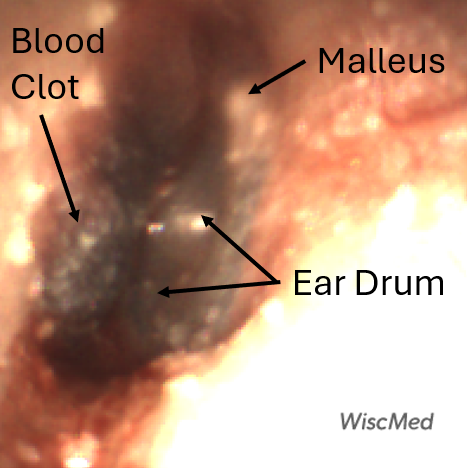
External Ear Canal Bleeding – January 25, 2024
A 7-year-old male presented to the emergency department (ED) with a chief complaint of bloody drainage from his left ear. His father reported the child was in his usual state of health when he went to bed that evening. However, he awoke with blood on his pillowcase and alerted his parents who brought him into the Pediatric ED. The child states he has ear pain. His parents deny any fevers, congestion, or other complaints. He has no prior history of ear infections. He has not been swimming and has no history of eczema or other rashes. He denies trauma but admits to using a Q-tip earlier in the day. His general examination is normal. He has dried blood on his outer ear. He denies tenderness with the manipulation of his external ear.
His Wispr digital otoscope exam is shown.
Which of the following is most likely true of the child’s condition?
- He has acute otitis media (AOM) and should be treated with oral antibiotics.
- He has otitis externa and should be treated with topical antibiotics.
- He has an injury to his auditory canal and topical antibiotics may be considered.
- He has hemotympanum and does not require antibiotics.
Answer: C. He has an injury to his auditory canal and topical antibiotics may be considered.
The child has an injury to the external auditory canal (EAC) and topical antibiotics are a prophylactic option. His Wispr exam nicely demonstrates what appears to be a small hematoma versus an area of clotted blood on the inferior surface, just proximal to the tympanic membrane (TM, ear drum). The TM itself appears normal without bulging or other evidence of infection as seen in acute otitis media. The malleus is visible. The EAC is not edematous or inflamed and he has no tenderness with manipulation of the external ear to suggest otitis externa. There is no bloody middle ear effusion as seen with hemotympanum. After further questioning (requiring some gentle probing), the family admitted the “Q-tip” used to clean his ears was a metal loop device. The child states the pain and bleeding occurred after this attempt at removing ear wax and is the obvious culprit in this case of the bleeding ear. Upon follow-up in 24 hours, the child’s ear canal had healed and there was no evidence of significant injury.
Here is the complete video exam.









































































































































































































